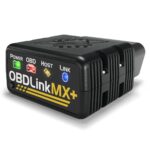ELM327 OBD2/CAN-Bus universal diagnostic scanners have revolutionized vehicle diagnostics, providing a cost-effective solution for both professionals and car enthusiasts. This guide explores the software ecosystem surrounding these devices, delving into its capabilities, applications, and the various tools available.
Understanding ELM327 and OBD2/CAN-Bus
The ELM327 is a microcontroller-based chip designed to translate vehicle data from the On-Board Diagnostics (OBD) system into a format readable by external devices like smartphones, laptops, and tablets. OBD, specifically OBD-II standardized in 1996, mandates a CAN-Bus (Controller Area Network) protocol for communication in most modern vehicles. This allows the ELM327 to access a wealth of diagnostic information.
Software Options for ELM327 Scanners
Numerous software options cater to ELM327 devices, ranging from free, open-source applications to commercially licensed professional suites. Choosing the right software depends on individual needs and technical proficiency.
Free and Open-Source Software
-
Python-CAN: This powerful Python library provides comprehensive CAN-Bus support, allowing users to develop custom diagnostic applications and scripts. It offers flexibility and granular control over data acquisition and analysis.
-
Can4python: Focusing on Linux SocketCAN, this package simplifies the handling of CAN-Bus signals, making it ideal for Linux users seeking a user-friendly interface.
Commercial Software
Commercial software typically provides user-friendly interfaces, extensive vehicle coverage, and advanced features like data logging, graphing, and troubleshooting guides. These often come with dedicated customer support and regular updates.
Key Features and Functionality
ELM327 software, regardless of being free or commercial, generally offers the following core functionalities:
- Reading and Clearing Diagnostic Trouble Codes (DTCs): Identify and erase error codes stored in the vehicle’s ECU, helping pinpoint malfunctions.
- Live Data Monitoring: Observe real-time sensor data like engine RPM, coolant temperature, and oxygen sensor readings to diagnose issues dynamically.
- Freeze Frame Data: Capture a snapshot of vehicle parameters at the moment a DTC is triggered, providing valuable context for diagnosis.
- Vehicle Specific Data: Access manufacturer-specific diagnostic information beyond generic OBD-II parameters.
Choosing the Right Software
Several factors should influence your software selection:
- Operating System Compatibility: Ensure the software supports your computer or mobile device’s operating system (Windows, macOS, Linux, Android, iOS).
- Vehicle Compatibility: Verify the software supports your vehicle’s make, model, and year. Coverage varies across different applications.
- Feature Requirements: Identify your specific needs, such as data logging, graphing, or advanced diagnostics, to select software with the necessary features.
- User Interface and Ease of Use: Choose software with an intuitive interface that aligns with your technical proficiency.
Conclusion
Elm327 Obd2/can-bus Universal Diagnostic Scanner Software provides a crucial bridge between your vehicle’s data and your diagnostic needs. With a diverse range of options available, from open-source libraries like Python-CAN to commercially developed applications, selecting the right software empowers you to perform effective vehicle diagnostics and maintenance. Consider your individual needs and technical capabilities to make an informed decision.

